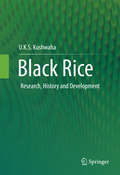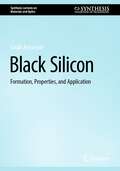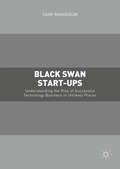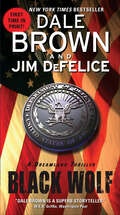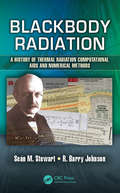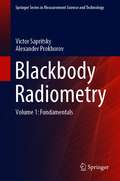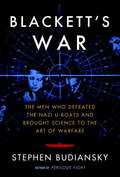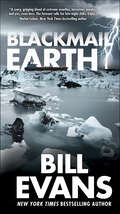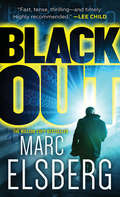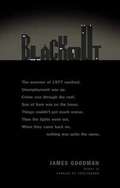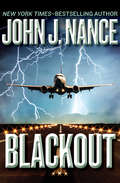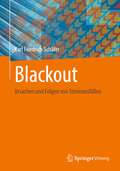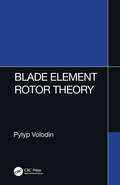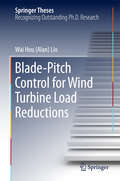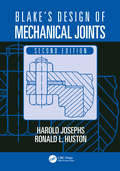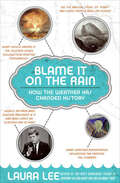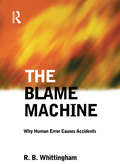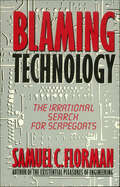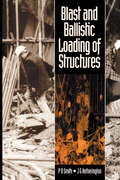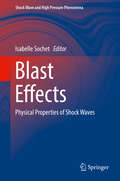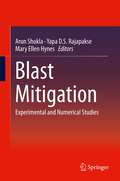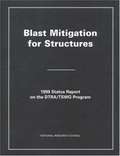- Table View
- List View
Black Rice: Research, History and Development
by U. K. S. KushwahaThe main purpose of this book is to introduce black rice to a wider circle of people. Although there has been research on different aspects of black rice, the information is scattered and not easily accessible to laypersons. The book intends to cover all aspects of black rice; from research, history, to its development. As such, the book will be suitable for both rice researchers and non-professionals who want to know more about this unique rice crop.
Black Silicon: Formation, Properties, and Application (Synthesis Lectures on Materials and Optics)
by Gagik AyvazyanThe book systematically accounts for the scientific and technological problems of nanostructured silicon in the form of porous and black silicon. Nanostructured silicon is currently a pioneer research topic worldwide due to its enormous potential applications for modern electronic devices, such as sensitive photodetectors, solar cells, biochemical sensors, hydrogen generators, and display devices. The main structural modifications of this nanomaterial are porous and black silicon. Porous silicon addresses crystalline silicon with nanopores and black silicon with nanoneedles. Historically, porous silicon is thought to be a kind of precursor to black silicon. The formation, research, and application of nanostructured silicon remains the main cornerstone of nanotechnologies, and this book is useful for a wide range of researchers in the fields of semiconductor physics, micro-, and nanoelectronics. The author outlines the prospect of black silicon fabrication and its various applications. As for porous silicon, the book contains a detailed analysis of this material as a precursor of black silicon. This allows it to be possible to carry out correlations between two structural modifications of nanostructured silicon to clearly and reasonably show their advantages and disadvantages. With many references to a vast resource of recently published literature, this book serves as an important and insightful source of valuable information and provides scientists and engineers with new ideas to better understand the formation processes of nanostructured silicon as well as improve and expand their properties.
Black Swan Start-ups: Understanding the Rise of Successful Technology Business in Unlikely Places
by Sami MahroumThis book explores startups that have thrived against the odds in places where startup success was deemed to be unlikely. Discussing a number of technology startups from around the world that have succeeded without state backing nor local venture and seed capital, Black Swan Start Ups provides unique insights into unsung models of success beyond the two dominant narratives of Asia's 'Tiger Economies' and America's Silicon Valley miracle. The author describes these stories of success as 'black swan events' and ascribes their achievements to the ability of entrepreneurs to leverage the 'place surplus' of their locations, while building connections to support networks outside their immediate geographies. Including case studies such as Skype in Estonia, SoundCloud in Germany and Bayt. Com in Dubai, this insightful book gives a holistic and wide-ranging view of how technology startups have, and can, succeed in less likely places.
Black Wolf: Black Wolf (Dreamland Thrillers #12)
by Dale Brown Jim DeFeliceWhen Russia unleashes an army of genetically enhanced assassins, the Dreamland team reunites to fight back in this military techno-thriller.The warriors of Dreamland have moved on. Some, like Breanna and Zen Stockard, to positions of power and influence; others, like Danny Freah and Nuri Lupo, into Whiplash, a cutting-edge combination of brain and brawn. Tasked by the President to handle the country’s most deadly and sensitive jobs, the elite SpecWarfare unit marries muscle to technological prowess.But can even Whiplash stand up to a covert Russian army of genetically enhanced assassins known only as the Wolves? They’re said to be nearly invisible and virtually unstoppable, endowed with super-human strength and endurance. But when Danny Freah and company are about to stumble on an even darker and deadlier secret: the most ferocious Wolf of them all comes from the heart of Dreamland itself—and Danny saw him die more than a decade before.
Blackbody Radiation: A History of Thermal Radiation Computational Aids and Numerical Methods (Optical Sciences and Applications of Light)
by Sean M. Stewart R. Barry JohnsonShelving Guide: Electrical Engineering In 1900 the great German theoretical physicist Max Planck formulated a correct mathematical description of blackbody radiation. Today, understanding the behavior of a blackbody is of importance to many fields including thermal and infrared systems engineering, pyrometry, astronomy, meteorology, and illumination. This book gives an account of the development of Planck’s equation together with many of the other functions closely related to it. Particular attention is paid to the computational aspects employed in the evaluation of these functions together with the various aids developed to facilitate such calculations. The book is divided into three sections. Section I – Thermal radiation and the blackbody problem are introduced and discussed. Early developments made by experimentalists and theoreticians are examined as they strove to understand the problem of the blackbody. Section II – The development of Planck’s equation is explained as are the all-important fractional functions of the first and second kinds which result when Planck’s equation is integrated between finite limits. A number of theoretical developments are discussed that stem directly from Planck’s law, as are the various computational matters that arise when numerical evaluation is required. Basic elements of radiometry that tie together and use many of the theoretical and computational ideas developed is also presented. Section III – A comprehensive account of the various computational aids such as tables, nomograms, graphs, and radiation slide rules devised and used by generations of scientists and engineers when working with blackbody radiation are presented as are more recent aids utilizing computers and digital devices for real-time computations. Scientists and engineers working in fields utilizing blackbody sources will find this book to be a valuable guide in understanding many of the computational aspects and nuances associated with Planck’s equation and its other closely related functions. With over 700 references, it provides an excellent research resource.
Blackbody Radiometry: Volume 1: Fundamentals (Springer Series in Measurement Science and Technology)
by Alexander Prokhorov Victor SapritskyThis book, the first of a two-volume set, focuses on the basic physical principles of blackbody radiometry and describes artificial sources of blackbody radiation, widely used as sources of optical radiation, whose energy characteristics can be calculated on the base of fundamental physical laws.Following a review of radiometric quantities, radiation laws, and radiative heat transfer, it introduces the basic principles of blackbody radiators design, details of their practical implementation, and methods of measuring their defining characteristics, as well as metrological aspects of blackbody-based measurements. Chapters are dedicated to the effective emissivity concept, methods of increasing effective emissivities, their measurement and modeling using the Monte Carlo method, techniques of blackbody radiators heating, cooling, isothermalization, and measuring their temperature.An extensive and comprehensive reference source, this book is of considerable value to students, researchers, and engineers involved in any aspect of blackbody radiometry.
Blackbox Algorithmus – Grundfragen einer Regulierung Künstlicher Intelligenz
by Mario MartiniDieses Buch liefert eine rechtswissenschaftliche Analyse der Chancen und Gefahren algorithmenbasierter Verfahren. Algorithmen, die im Maschinenraum moderner Softwareanwendungen werkeln, sind zu zentralen Steuerungsinstanzen der digitalen Gesellschaft avanciert. Immer nachhaltiger beeinflussen sie unser Leben. Ihre Funktionsweise gleicht aber teilweise einer Blackbox. Die in ihr schlummernden Risiken zu bändigen, fordert die Rechtsordnung heraus. Das Buch beleuchtet die gesellschaftlichen Gefahren einer zunehmenden gesellschaftlichen Steuerung durch Algorithmen und entwickelt erste Regulierungsideen, mit deren Hilfe sich die Wertschöpfungspotenziale automatisierter digitaler Prozesse mit den Grundwerten der Rechtsordnung versöhnen lassen.
Blackett's War
by Stephen BudianskyThe exciting history of a small group of British and American scientists who, during World War II, developed the new field of operational research to turn back the tide of German submarines--revolutionizing the way wars are waged and won. In March 1941, after a year of unbroken and devastating U-boat onslaughts, the British War Cabinet decided to try a new strategy in the foundering naval campaign. To do so, they hired an intensely private, bohemian physicist who was also an ardent socialist. Patrick Blackett was a former navy officer and future winner of the Nobel Prize; he is little remembered today, but he and his fellow scientists did as much to win the war against Nazi Germany as almost anyone else. As director of the World War II antisubmarine effort, Blackett used little more than simple mathematics and probability theory--and a steadfast belief in the utility of science--to save the campaign against the U-boat. Employing these insights in unconventional ways, from the washing of mess hall dishes to the color of bomber wings, the Allies went on to win essential victories against Hitler's Germany. Here is the story of these civilian intellectuals who helped to change the nature of twentieth-century warfare. Throughout, Stephen Budiansky describes how scientists became intimately involved with what had once been the distinct province of military commanders--convincing disbelieving military brass to trust the solutions suggested by their analysis. Budiansky shows that these men above all retained the belief that operational research, and a scientific mentality, could change the world. It's a belief that has come to fruition with the spread of their tenets to the business and military worlds, and it started in the Battle of the Atlantic, in an attempt to outfight the Germans, but most of all to outwit them.
Blackmail Earth
by Bill EvansThe Morning Show's star meteorologist, Jenna Withers, reports on the blistering conditions of a nationwide drought every day. But nothing this alluring young woman has ever experienced can prepare her for the terrifying intersection of extreme weather and extreme politics. After Jenna receives a controversial appointment to a special White House task force on geoengineering, she learns about a lot more than the President's desire to use technology to address global warming. Through old contacts, Jenna hears that Muslim extremists in the Maldives have begun to publicly blame the West for the rising seas that imperil the tiny Pacific island nation. They are planning a suicide bombing that could lead to a sudden and disastrous cooling of the planet. Rick Birk, an aging, alcoholic colleague of Jenna's, is dispatched to report on the turmoil in the Maldives. To his—and everyone else's—shock, he becomes a central – and bizarre – figure in the unfolding panic.News of the Islamist threat sets off an even more horrifying plan in North Korea. The Supreme Leader, desperate for aid, threatens to hold the world hostage with his own, disaster-creating brand of geoengineering, one that takes aim at the skies.Those escalating international tensions are set against the grisly murder of an intriguing Pagan woman in rural New York, Jenna Withers's budding romance with an organic dairy farmer, and a fiercely contested presidential campaign.This swiftly paced tale takes Jenna from the Oval Office to the sandy shores of the Indian Ocean, from the sophisticated set of The Morning Show to her new boyfriend's dusty dairy farm. Filled with fascinating and unusual characters, and told from multiple and deeply moving points of view, Blackmail Earth culminates in a furious battle raging in the heart of Manhattan.At the Publisher's request, this title is being sold without Digital Rights Management Software (DRM) applied.
Blackout: A Novel
by Marc Elsberg"Fast, tense, thrilling — and timely: this will happen one day. Highly recommended." —Lee Child, #1 New York Times bestselling author of the Jack Reacher seriesThis is no accident.This is no act of God. This is Blackout.A terrifyingly plausible million-copy selling debut disaster thriller. When the lights go out one night, no one panics. Not yet. The lights always come back on soon, don't they? Surely it's a glitch, a storm, a malfunction. But something seems strange about this night. Across Europe, controllers watch in disbelief as electrical grids collapse. There is no power, anywhere. A former hacker and activist, Piero investigates a possible cause of the disaster. The authorities don't believe him, and he soon becomes a prime suspect himself. With the United States now also at risk, Piero goes on the run with Lauren Shannon, a young American CNN reporter based in Paris, desperate to uncover who is behind the attacks. After all, the power doesn't just keep the lights on—it keeps us alive.
Blackout: With an Afterword on the Blackout of 2003
by James E. GoodmanOn July 13, 1977, there was a blackout in New York City. With the dark came excitement, adventure, and fright in subway tunnels, office towers, busy intersections, bus terminals, high-rise stairwells, hotel lobbies, elevators, and hospitals. There was revelry in bars and restaurants, music and dancing in the streets. On block after block, men and women proved themselves heroes by helping neighbors and strangers make it through the night. Unfortunately, there was also widespread looting, vandalism, and arson, and even before the police restored order, people began to ask and argue about why. Why did people do what they did when the lights went out?
Blackout: The Last Hostage And Blackout (The Kat Bronsky Thrillers #2)
by John J. NanceNew York Times–Bestselling Author: An FBI agent uncovers a conspiracy to send planes falling from the sky in this &“white-knuckle adventure&” (Publishers Weekly). A Boeing/McDonnell-Douglas MD-11 jetliner crashes into the Gulf of Mexico a mile inside Cuban waters, killing all three hundred and twenty passengers onboard. The last three minutes on the plane&’s cockpit voice and data recorders have been erased. Was this a massive mechanical failure or an act of terrorism? At an air terrorism conference, FBI agent Kat Bronsky learns Washington Post reporter Robert McCabe has received frightening information about the MD-11 crash from a source that mysteriously disappeared. When another airliner goes down after its pilots are flash-blinded midflight, Bronsky and McCabe find themselves at the center of what might be a deadly government cover-up. Unable to trust her colleagues at the FBI, Bronsky must rely on her own wits and piloting skills as she races from the jungles of Vietnam to the forests of the American Northwest to unmask the conspirators before the entire American airline industry comes crashing out of the sky. John J. Nance is in top form with this suspense-charged, action-packed novel that solidifies his reputation as the king of the aviation thriller.
Blackout
by John J. NanceNance's new airliner adventure rides on his stock-in-trade of plane crashes, pilot jargon, and airport protocol. Robert McCabe, a reporter investigating a story of possible U.S. government involvement in a recent spate of air crashes, is attempting to elude the goons trying to snatch his info-laden laptop in Hong Kong. His flight out of town, after a brilliant flash blinds the pilots, continues the string of aerial disasters; he and a few others miraculously survive the crash in Vietnam. Then they weather a fusillade from a helicopter and are rescued by FBI agent Kat Bronsky, on the scene just in time, naturally. The harried band then wends its way back across the Pacific, affording them time to theorize about the mayhem to which they've been subjected, while intermittently being shot at by people with poor aim but plenty of perseverance. Undergoing more hairbreadth escapes, they proceed to Seattle, then to Sun Valley, locale of the climactic finale. This will be popular with the aviation-minded, if not with those who expect finesse in their thrillers.
Blackout: Ursachen und Folgen von Stromausfällen
by Karl Friedrich SchäferDieses Buch beschreibt die unterschiedlichen Ursachen, aus denen sich Blackouts entwickeln können, sowie die technischen, wirtschaftlichen und sozialen Folgen in den verschiedenen Bereichen der kritischen Infrastrukturen bei länger andauernden Unterbrechungen der Stromversorgung. Anhand eines exemplarischen Ablaufs werden die zeitlich gestaffelten Ereignisse skizziert, die aufgrund eines Blackouts auftreten. Die Ursachen, der Ablauf und die Auswirkungen von Blackouts, die sich in den letzten Jahren ereignet haben, sind ebenfalls Bestandteil dieses Buches. Abschließend werden Maßnahmen zur Vermeidung von Blackouts sowie die Abläufe zum Wiederaufbau des Energieversorgungssystems beschrieben.
Blade Element Rotor Theory
by Pylyp VolodinBlade Element Rotor Theory This book presents an extension of the conventional blade element rotor theory to describe the dynamic properties of helicopter rotors. The presented theory focuses on the accurate mathematical determination of the forces and moments by which a rotor affects its rotorcraft at specified flight conditions and control positions. Analyzing the impact of a blade's non-uniform properties, the book covers blade twisting, the non-rectangular planform shape of a blade, and inhomogeneous airfoil along the blade. It discusses inhomogeneous induced airflow around a rotor disc in terms of the blade element rotor theory. This book also considers the impact of flapping hinge offset on the rotor's dynamic properties. Features • Focuses on a comprehensive description and accurate determination of the rotor's aerodynamic properties • Presents precise helicopter rotor properties with inhomogeneous aerodynamic properties of rotor blades • Considers inhomogeneous distribution of induced flow • Discusses a mathematical model of a main helicopter rotor for a helicopter flight simulator This book is intended for graduate students and researchers studying rotor dynamics and helicopter flight dynamics
Blade-Pitch Control for Wind Turbine Load Reductions
by Wai Hou LioThis thesis investigates the use of blade-pitch control and real-time wind measurements to reduce the structural loads on the rotors and blades of wind turbines. The first part of the thesis studies the main similarities between the various classes of current blade-pitch control strategies, which have to date remained overlooked by mainstream literature. It also investigates the feasibility of an estimator design that extracts the turbine tower motion signal from the blade load measurements. In turn, the second part of the thesis proposes a novel model predictive control layer in the control architecture that enables an existing controller to incorporate the upcoming wind information and constraint-handling features. This thesis provides essential clarifications of and systematic design guidelines for these topics, which can benefit the design of wind turbines and, it is hoped, inspire the development of more innovative mechanical load-reduction solutions in the field of wind energy.
Blake's Design of Mechanical Joints (Mechanical Engineering)
by Harold Josephs Ronald L. HustonBlake's Design of Mechanical Joints, Second Edition, is an updated revision of Alexander Blake’s authoritative book on mechanical joint and fastener design. This revision brings Blake’s 1985 volume up-to-date with modern developments in joint design, and recent technological advances in metallic and non-metallic materials, and in adhesive joining technologies. The book retains Blake’s lucid, readable style and his balance of basic concepts with practical applications. Coverage of statistical methods, computational software usage, extensive examples, and a full glossary have been added to make the new edition a comprehensive, practical sourcebook for today's mechanical design engineers.
Blame It on the Rain: How the Weather Has Changed History
by Laura LeeAn amazing, enlightening, and endlessly entertaining look at how weather has shaped our world.Throughout history, great leaders have fallen, the outcomes of mighty battles have been determined, and the tides of earth-shattering events have been turned by a powerful, inscrutable force of nature: the weather. In Blame It on the Rain, author Laura Lee explores the amazing and sometimes bizarre ways in which weather has influenced our history and helped to bring about sweeping cultural change. She also delights us with a plethora of fascinating weather-related facts (Did you know that more Britons die of sunburn every year than Australians?), while offering readers a hilarious overview of humankind's many absurd attempts to control the elements.If a weather-produced blight hadn't severely damaged French vineyards, there might never have been a California wine industry. . . .What weather phenomenon was responsible for the sound of the Stradivarius?If there had been a late autumn in Russia, Hitler could have won World War II. . . .Did weather play a part in Truman's victory over Dewey?Eye-opening, edifying, and totally unexpected, Blame It on the Rain is a fascinating appreciation of the destiny-altering vagaries of mother nature—and it's even more fun than watching the Weather Channel!
The Blame Machine: Why Human Error Causes Accidents
by Robert WhittinghamThe Blame Machine describes how disasters and serious accidents result from recurring, but potentially avoidable, human errors. It shows how such errors are preventable because they result from defective systems within a company. From real incidents, you will be able to identify common causes of human error and typical system deficiencies that have led to these errors. On a larger scale, you will be able to see where, in the organisational or management systems, failure occurred so that you can avoid them.The book also describes the existence of a 'blame culture' in many organisations, which focuses on individual human error whilst ignoring the system failures that caused it. The book shows how this 'blame culture' has, in the case of a number of past accidents, dominated the accident enquiry process hampering a proper investigation of the underlying causes.Suggestions are made about how progress can be made to develop a more open culture in organisations, both through better understanding of human error by managers and through increased public awareness of the issues. The book brings together documentary evidence from recent major incidents from all around the world and within the Rail, Water, Aviation, Shipping, Chemical and Nuclear industries.Barry Whittingham has worked as a senior manager, design engineer and consultant for the chemical, nuclear, offshore oil and gas, railway and aviation sectors. He developed a career as a safety consultant specializing in the human factors aspects of accident causation. He is a member of the Human Factors in Reliability Group, and a Fellow of the Safety and Reliability Society.
Blaming Technology: The Irrational Search for Scapegoats
by Samuel C. FlormanBlaming Technology: The Irrational Search for Scapegoats is Samuel C. Florman's 1981 discussion of the state of technology and engineering in the United States, including the pros and cons, and the public's perceptions and opinions.
Blast and Ballistic Loading of Structures
by John Hetherington Peter SmithThis book brings together, in a concise format, the key elements of the loads produced from explosive sources, and how they interact with structures. Explosive sources include gas, high explosives, dust and nuclear materials.It presents quantitative information and design methods in a useable form without recourse to extensive mathematical ana
Blast Disease of Cereal Crops: Evolution and Adaptation in Context of Climate Change (Fungal Biology)
by Rajan Sharma S. Chandra Nayaka H. Rajashekara Ganesan Prakash C. Tara SatyavathiBlast is an important foliar disease that infects the majority of cereal crops like rice, finger millet, pearl millet, foxtail millet and wheat, and thus resulting in a huge economic impact. The pathogen is responsible for causing epidemics in many crops and commonly shifts to new hosts. Magnaporthe spp. is the most prominent cause of blast disease on a broad host range of grasses including rice as well as other species of poaceae family. To date, 137 members of Poaceae hosting this fungus have been described in Fungal Databases. This book provides information on all blast diseases of different cereal crops. The pathogen evolves quickly due to its high variability, and thus can quickly adapt to new cultivars and cause an epidemic in a given crop. Some of the topics covered here include historical perspectives, pathogen evolution, host range shift, cross-infectivity, and pathogen isolation, use of chemicals fungicides, genetics and genomics, and management of blast disease in different cereal crops with adoption of suitable methodologies.In the past two decades there have been significant developments in genomics and proteomics approaches and there has been substantial and rapid progress in the cloning and mapping of R genes for blast resistance, as well as in comparative genomics analysis for resolving delineation of Magnaporthe species that infect both cereals and grass species. Blast disease resistance follows a typical gene-for-gene hypothesis. Identification of new Avr genes and effector molecules from Magnaporthe spp. can be useful to understand the molecular mechanisms involved in the fast evolution of different strains of this fungal genus. Advances in these areas may help to reduce the occurrence of blast disease by the identification of potential R genes for effective deployment. Additionally, this book highlights the importance of blast disease that infects different cereal hosts in the context of climate change, and genomics approaches that may potentially help in understanding and applying new concepts and technologies that can make real impact in sustainable management of blast disease in different cereal crops.
Blast Effects: Physical Properties of Shock Waves (Shock Wave and High Pressure Phenomena)
by Isabelle SochetThis book compiles a variety of experimental data on blast waves. The book begins with an introductory chapter and proceeds to the topic of blast wave phenomenology, with a discussion Rankine-Hugoniot equations and the Friedlander equation, used to describe the pressure-time history of a blast wave. Additional topics include arrival time measurement, the initiation of detonation by exploding wires, a discussion of TNT equivalency, and small scale experiments. Gaseous and high explosive detonations are covered as well. The topics and experiments covered were chosen based on the comparison of used scale sizes, from small to large. Each characteristic parameter of blast waves is analyzed and expressed versus scaled distance in terms of energy and mass. Finally, the appendix compiles a number of polynomial laws that will prove indispensable for engineers and researchers.
Blast Mitigation: Experimental and Numerical Studies
by Arun Shukla Mary Ellen Hynes Yapa Ds RajapakseBlast Mitigation: Experimental and Numerical Studies covers both experimental and numerical aspects of material and structural response to dynamic blast loads and its mitigation. The authors present the most up-to-date understanding from laboratory studies and computational analysis for researchers working in the field of blast loadings and their effect on material and structural failure, develop designs for lighter and highly efficient structural members for blast energy absorption, discuss vulnerability of underground structures, present methods for dampening blast overpressures, discuss structural post blast collapse and give attention to underwater explosion and implosion effects on submerged infrastructure and mitigation measures for this environment.
Blast Mitigation for Structures: 1999 Status Report on the DTRA/TSWG Program
by National Research CouncilThe Blast Mitigation for Structures Program (BMSP) is a research and development activity conducted by the Defense Threat Reduction Agency (DTRA) to improve the performance of buildings that are targets of terrorist attack. The primary goal of the BMSP is to reduce loss of life and injuries to the occupants of these buildings through the development of innovative techniques for new structures and retrofitting existing facilities. The committee's findings and recommendations are contained in this initial assessment report.
